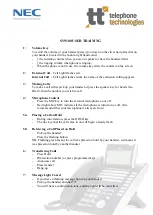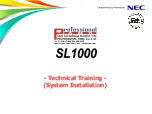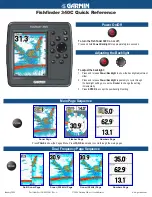
9-10
L60 Line Phase Comparison System
GE Multilin
9.2 DISTANCE BACKUP/SUPERVISION
9 APPLICATION OF SETTINGS
9
ation should also be given to a situation where the load impedance may enter into the relay characteristic for a time longer
than the chosen time delay, which could occur transiently during a system power swing. For this reason the power swing
blocking function should be used.
9.2.10 GROUND DISTANCE
a) NEUTRAL CURRENT SUPERVISION
The current supervision for the ground distance elements responds to an internally calculated neutral current (3 × I_0). The
setting for this element should be based on twice the zero-sequence line capacitance current or the maximum zero-
sequence unbalance under maximum load conditions. This element should not be used to prevent an output when the load
impedance is inside the distance characteristic on a steady state basis.
b) GROUND DISTANCE ZONE 1
The zone 1 reach must be set so that nominally instantaneous operation does not extend beyond the end of the protected
line. However this may be somewhat more complicated than for the phase elements, because of zero sequence mutual
induction with an adjacent parallel line, possibly carried on the same tower, which can be out of service and grounded at
multiple points. A fault beyond 100% of the protected line may cause overreach unless the reach is reduced significantly,
sometimes as low as 65% of the line length. If the line being protected does not have a significant interaction with an adja-
cent circuit, then the typical 80% setting may be used. If there is significant mutual coupling between the parallel lines, then
the mutual compensation feature of the ground distance elements can be used instead of a drastic reduction in the reach.
However, even in this case, there is more uncertainty as compared with the phase distance elements because the zero-
sequence impedance of the line and thus the zero-sequence-compensating factors may vary significantly due to weather
and other conditions.
c) GROUND DISTANCE ZONE 2
To ensure that the zone 2 can see 100% of the line, inter-circuit mutual effects must be considered, as they can contribute
to a significant under-reach. Typically this may occur on double circuit lines, when both lines may carry the same current.
An analytical study should be carried out to determine the appropriate reach setting.
The main purpose of this element is to operate for faults beyond the reach of the local zone 1 element, and therefore a time
delay must be used similar to the phase fault case.
d) GROUND DISTANCE ZONE 3
This remote back up function must have a reach which is set to account for any infeed at the remote bus, plus the imped-
ance of the longest line which terminates on this remote bus. Similar to the phase fault case, a zone 3 element must be
time coordinated with timed clearances on the next section.
Summary of Contents for L60
Page 10: ...x L60 Line Phase Comparison System GE Multilin TABLE OF CONTENTS ...
Page 57: ...GE Multilin L60 Line Phase Comparison System 2 27 2 PRODUCT DESCRIPTION 2 3 SPECIFICATIONS 2 ...
Page 58: ...2 28 L60 Line Phase Comparison System GE Multilin 2 3 SPECIFICATIONS 2 PRODUCT DESCRIPTION 2 ...
Page 482: ...6 26 L60 Line Phase Comparison System GE Multilin 6 5 PRODUCT INFORMATION 6 ACTUAL VALUES 6 ...
Page 554: ...10 8 L60 Line Phase Comparison System GE Multilin 10 2 BATTERIES 10 MAINTENANCE 10 ...
Page 674: ...B 110 L60 Line Phase Comparison System GE Multilin B 4 MEMORY MAPPING APPENDIX B B ...
Page 704: ...C 30 L60 Line Phase Comparison System GE Multilin C 7 LOGICAL NODES APPENDIX C C ...
Page 720: ...E 10 L60 Line Phase Comparison System GE Multilin E 1 PROTOCOL APPENDIX E E ...
Page 732: ...F 12 L60 Line Phase Comparison System GE Multilin F 2 DNP POINT LISTS APPENDIX F F ...
Page 742: ...H 8 L60 Line Phase Comparison System GE Multilin H 3 WARRANTY APPENDIX H H ...
















































